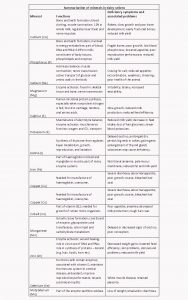 Feb 1,2020
Feb 1,2020

Changing trends in animal production require the owner/manager to focus on major economic contributors as reproduction and nutrition. Efficient production in domestic animals requires for essential nutrients in a diet be provided in appropriate amounts and in forms that are biologically available.
Minerals are inorganic (not of plant or animal origin) elements required by the body of the animal for optimum growth and proper muscle and nerve function. In addition, they are essential components of body enzymes, hormones and cells. Mineral absorption is lower relative to other nutrients. Some inorganic sources of trace minerals are more available than others (i.e. Sulphates are more available than Oxides). Organic minerals classified as chelates or proteinates are absorbed in the intestine by a different mechanism that increases bioavailability. Organic minerals are generally more expensive. As a thumb rule one fifth of trace minerals should come from organic mineral sources. A single element complexed to a single amino acid is most preferred form of organic trace minerals.
There are a number of minerals essential for maintenance, growth, production and reproduction of dairy animals. Minerals required in large amounts are referred as macro-minerals and include calcium, phosphorous, sodium, chlorine, potassium, magnesium and sulphur. The macro-minerals are important structural components of bone and other tissues and serve as important constituents of body fluids. They play vital roles in the maintenance of acid base balance, osmotic pressure, membrane electric potential and nervous transmission.
Minerals required in smaller amounts are referred to as micro or trace minerals. This group includes cobalt, copper, iodine, iron, manganese, molybdenum, selenium, zinc and chromium. The trace minerals serve as components of enzyme and hormones.
In dairy cattle, two key goals are adequate nutrition and adequate mammary health so as to produce wholesome milk. Minerals play a significant role in herd fertility. Organic minerals have beneficial role to play in resumption of follicular growth and fertility in dairy cows.
Trace element deficiency may be linked to retained foetal membranes (Gupta et al 2005), abortion (Mee, 2004). Deficiency of selenium and iodine results in high incidence of retained foetal membrane. The trace element status of dairy cows is very important for fertility in the following lactation. Calcium related disorders are mostly very common during parturition or within few days of parturition. Calcium deficiency leads to prolonged first estrus, ovulation, increased incidence of dystocia, retention of placenta. Sodium deficiency prevents utilisation of protein and energy. Deficiency of potassium causes muscle weakness. Deficiency of copper leads to early embryonic death and re-absorption of embryo (Miller et al, 1988), increased chances of retained placenta (O’Dell 1990) and low fertility (Howell and Hall, 1930). Deficiency of molybdenum leads to decreased libido in male and delayed puberty, reduced conception rate and anoestrus in female (Sathish Kumar, 2003); zinc essential for proper sexual maturity, reproductive capacity, fertility and normal reproductive events in females (Sathish Kumar, 2003). Deficiency of manganese cause poor fertility; Responsible for silent estrus and anoestrus (Corrah, 1996); Important for cholesterol synthesis (Keou, 1990)

The requirement for minerals by dairy animals is influenced by several factors including age, stage of pregnancy and stage of lactation. Minerals perform an essential role in dairy cow reproduction and hoof health. Trace minerals play critical role in proper functioning of enzymes, hormones and cells. Deficiency can and often do result in less than optimal performance and lost opportunity cost, directly affecting the milk production, health, fertility and conception.